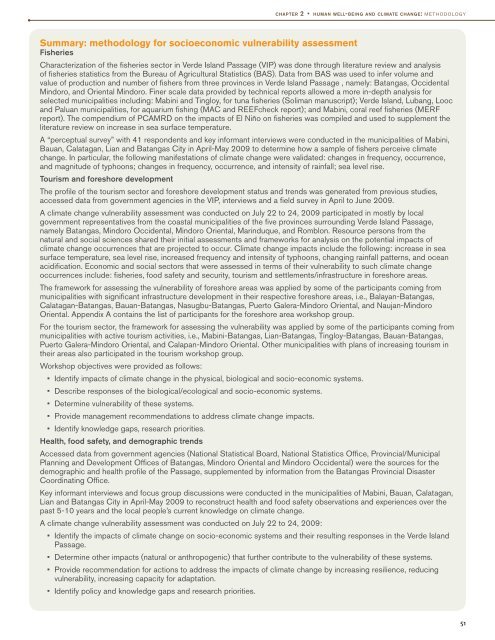of the Verde Island Passage, Philippines - weADAPT
of the Verde Island Passage, Philippines - weADAPT
of the Verde Island Passage, Philippines - weADAPT
Create successful ePaper yourself
Turn your PDF publications into a flip-book with our unique Google optimized e-Paper software.
chapter 2 • human well-being and climate change: methodology<br />
Summary: methodology for socioeconomic vulnerability assessment<br />
Fisheries<br />
Characterization <strong>of</strong> <strong>the</strong> fisheries sector in <strong>Verde</strong> <strong>Island</strong> <strong>Passage</strong> (VIP) was done through literature review and analysis<br />
<strong>of</strong> fisheries statistics from <strong>the</strong> Bureau <strong>of</strong> Agricultural Statistics (BAS). Data from BAS was used to infer volume and<br />
value <strong>of</strong> production and number <strong>of</strong> fishers from three provinces in <strong>Verde</strong> <strong>Island</strong> <strong>Passage</strong> , namely: Batangas, Occidental<br />
Mindoro, and Oriental Mindoro. Finer scale data provided by technical reports allowed a more in-depth analysis for<br />
selected municipalities including: Mabini and Tingloy, for tuna fisheries (Soliman manuscript); <strong>Verde</strong> <strong>Island</strong>, Lubang, Looc<br />
and Paluan municipalities, for aquarium fishing (MAC and REEFcheck report); and Mabini, coral reef fisheries (MERF<br />
report). The compendium <strong>of</strong> PCAMRD on <strong>the</strong> impacts <strong>of</strong> El Niño on fisheries was compiled and used to supplement <strong>the</strong><br />
literature review on increase in sea surface temperature.<br />
A “perceptual survey” with 41 respondents and key informant interviews were conducted in <strong>the</strong> municipalities <strong>of</strong> Mabini,<br />
Bauan, Calatagan, Lian and Batangas City in April-May 2009 to determine how a sample <strong>of</strong> fishers perceive climate<br />
change. In particular, <strong>the</strong> following manifestations <strong>of</strong> climate change were validated: changes in frequency, occurrence,<br />
and magnitude <strong>of</strong> typhoons; changes in frequency, occurrence, and intensity <strong>of</strong> rainfall; sea level rise.<br />
Tourism and foreshore development<br />
The pr<strong>of</strong>ile <strong>of</strong> <strong>the</strong> tourism sector and foreshore development status and trends was generated from previous studies,<br />
accessed data from government agencies in <strong>the</strong> VIP, interviews and a field survey in April to June 2009.<br />
A climate change vulnerability assessment was conducted on July 22 to 24, 2009 participated in mostly by local<br />
government representatives from <strong>the</strong> coastal municipalities <strong>of</strong> <strong>the</strong> five provinces surrounding <strong>Verde</strong> <strong>Island</strong> <strong>Passage</strong>,<br />
namely Batangas, Mindoro Occidental, Mindoro Oriental, Marinduque, and Romblon. Resource persons from <strong>the</strong><br />
natural and social sciences shared <strong>the</strong>ir initial assessments and frameworks for analysis on <strong>the</strong> potential impacts <strong>of</strong><br />
climate change occurrences that are projected to occur. Climate change impacts include <strong>the</strong> following: increase in sea<br />
surface temperature, sea level rise, increased frequency and intensity <strong>of</strong> typhoons, changing rainfall patterns, and ocean<br />
acidification. Economic and social sectors that were assessed in terms <strong>of</strong> <strong>the</strong>ir vulnerability to such climate change<br />
occurrences include: fisheries, food safety and security, tourism and settlements/infrastructure in foreshore areas.<br />
The framework for assessing <strong>the</strong> vulnerability <strong>of</strong> foreshore areas was applied by some <strong>of</strong> <strong>the</strong> participants coming from<br />
municipalities with significant infrastructure development in <strong>the</strong>ir respective foreshore areas, i.e., Balayan-Batangas,<br />
Calatagan-Batangas, Bauan-Batangas, Nasugbu-Batangas, Puerto Galera-Mindoro Oriental, and Naujan-Mindoro<br />
Oriental. Appendix A contains <strong>the</strong> list <strong>of</strong> participants for <strong>the</strong> foreshore area workshop group.<br />
For <strong>the</strong> tourism sector, <strong>the</strong> framework for assessing <strong>the</strong> vulnerability was applied by some <strong>of</strong> <strong>the</strong> participants coming from<br />
municipalities with active tourism activities, i.e., Mabini-Batangas, Lian-Batangas, Tingloy-Batangas, Bauan-Batangas,<br />
Puerto Galera-Mindoro Oriental, and Calapan-Mindoro Oriental. O<strong>the</strong>r municipalities with plans <strong>of</strong> increasing tourism in<br />
<strong>the</strong>ir areas also participated in <strong>the</strong> tourism workshop group.<br />
Workshop objectives were provided as follows:<br />
• Identify impacts <strong>of</strong> climate change in <strong>the</strong> physical, biological and socio-economic systems.<br />
• Describe responses <strong>of</strong> <strong>the</strong> biological/ecological and socio-economic systems.<br />
• Determine vulnerability <strong>of</strong> <strong>the</strong>se systems.<br />
• Provide management recommendations to address climate change impacts.<br />
• Identify knowledge gaps, research priorities.<br />
Health, food safety, and demographic trends<br />
Accessed data from government agencies (National Statistical Board, National Statistics Office, Provincial/Municipal<br />
Planning and Development Offices <strong>of</strong> Batangas, Mindoro Oriental and Mindoro Occidental) were <strong>the</strong> sources for <strong>the</strong><br />
demographic and health pr<strong>of</strong>ile <strong>of</strong> <strong>the</strong> <strong>Passage</strong>, supplemented by information from <strong>the</strong> Batangas Provincial Disaster<br />
Coordinating Office.<br />
Key informant interviews and focus group discussions were conducted in <strong>the</strong> municipalities <strong>of</strong> Mabini, Bauan, Calatagan,<br />
Lian and Batangas City in April-May 2009 to reconstruct health and food safety observations and experiences over <strong>the</strong><br />
past 5-10 years and <strong>the</strong> local people’s current knowledge on climate change.<br />
A climate change vulnerability assessment was conducted on July 22 to 24, 2009:<br />
• Identify <strong>the</strong> impacts <strong>of</strong> climate change on socio-economic systems and <strong>the</strong>ir resulting responses in <strong>the</strong> <strong>Verde</strong> <strong>Island</strong><br />
<strong>Passage</strong>.<br />
• Determine o<strong>the</strong>r impacts (natural or anthropogenic) that fur<strong>the</strong>r contribute to <strong>the</strong> vulnerability <strong>of</strong> <strong>the</strong>se systems.<br />
• Provide recommendation for actions to address <strong>the</strong> impacts <strong>of</strong> climate change by increasing resilience, reducing<br />
vulnerability, increasing capacity for adaptation.<br />
• Identify policy and knowledge gaps and research priorities.<br />
51
















